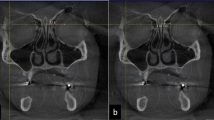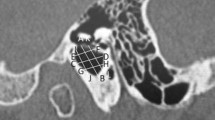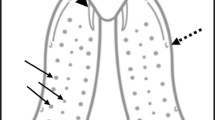Abstract
Purpose
The computed tomography (CT) study investigates the olfactory fossa (OF) morphometry and morphology.
Methods
Fifty Greek adult dried skulls were macroscopically investigated for the detection of the OF morphological patterns and after a multiplanar CT reconstruction, the OF morphometry was accurately calculated using a digital ruler.
Results
Types I and II surface contour patterns were the most frequently identified (36 and 32%), followed by types III, IV, and V (16, 12, and 4%). Crista galli mean length, height, and width were 19.46 ± 2.34 mm, 12.69 ± 2.7 mm, and 5.18 ± 1.11 mm. The OF mean maximum length was 22.29 ± 2.16 mm on the right and 22.10 ± 2.44 mm on the left side, and symmetry was detected. The OF median values of the maximum depth for its anterior, middle, and posterior third were 4.91 mm, 4.72 mm, and 2.78 mm on the right and 4.55 mm, 4.75 mm, and 2.55 mm on the left side. Symmetry was observed in any third of the OF. The OF median values of the surface maximum width for the anterior, middle, and posterior thirds were 9.29 mm, 11.48 mm, and 13.07 mm. A significant gradual increase of the OF surface maximum width was detected in the anteroposterior direction in the total sample (p < 0.001), with the highest value (23.12 mm) in the posterior third. A significant (p < 0.001) very strong (rs = −0.798) and a moderate (rs = −0.524) negative linear correlation in the OF anterior and middle third were, respectively, identified between its maximum depth and width. No gender impact was identified.
Conclusions
The study helps to familiarize with the calculation of the OF dimensions and simplifies the understanding of its complex anatomy, to reach successful surgical planning and minimize perioperative complications.







Similar content being viewed by others
References
Adeel M, Ikram M, Rajput MS, Arain A, Khattak YJ (2013) Asymmetry of lateral lamella of the cribriform plate: a software-based analysis of coronal computed tomography and its clinical relevance in endoscopic sinus surgery. Surg Radiol Anat 35:843–847. https://doi.org/10.1007/s00276-013-1106-4
Alazzawi S, Omar R, Rahmat K, Alli K (2012) Radiological analysis of the ethmoid roof in the Malaysian population. Auris Nasus Larynx 39:393–396. https://doi.org/10.1016/j.anl.2011.10.002
Babu AC, Nair M, Kuriakose AM (2018) Olfactory fossa depth: CT analysis of 1200 patients. Indian J Radiol Imaging 28:395–400. https://doi.org/10.4103/ijri.IJRI_119_18
Chong VF, Fan YF, Lau D, Sethi DS (1998) Functional endoscopic sinus surgery (FESS): what radiologists need to know. Clin Radiol 53:650–658. https://doi.org/10.1016/s0009-9260(98)80291-2
Coelho DH, Pence TS, Abdel-Hamid M, Costanzo RM (2018) Cribriform plate width is highly variable within and between subjects. Auris Nasus Larynx 45:1000–1005. https://doi.org/10.1016/j.anl.2018.01.013
Gauba V, Saleh GM, Dua G, Agarwal S, Ell S, Vize C (2006) Radiological classification of anterior skull base anatomy prior to performing medial orbital wall decompression. Orbit 25:93–96. https://doi.org/10.1080/01676830600674627
Giannetti AV, Guimarães RE, Santiago AP, Perpétuo FO, Machado MA (2012) A tomographic study of the skull base in primary spontaneous cerebrospinal fluid leaks. Neuroradiology 54:459–466. https://doi.org/10.1007/s00234-011-0901-z
Gupta P, Ramesh P (2017) Radiological observation of ethmoid roof on basis of keros classification and its application in endonasal surgery. Int J Anat Res 5:4204–4207. https://doi.org/10.16965/ijar.2017.284
Jacob TG, Kaul JM (2014) Morphology of the olfactory fossa—a new look. J Anat Soc India 63:30–35. https://doi.org/10.1016/j.jasi.2014.04.006
Jones TM, Almahdi JM, Bhalla RK, Lewis-Jones H, Swift AC (2002) The radiological anatomy of the anterior skull base. Clin Otolaryngol Allied Sci 27:101–105. https://doi.org/10.1046/j.1365-2273.2002.00540.x
Kainz J, Stammberger H (1988) Das Dach des vorderen Siebbeines: Ein Locus minoris resistentiae an der Schädelbasis [The roof of the anterior ethmoid: a locus minoris resistentiae in the skull base]. Laryngol Rhinol Otol (Stuttg) 67:142–149
Kaplanoglu H, Kaplanoglu V, Dilli A, Toprak U, Hekimoğlu B (2013) An analysis of the anatomic variations of the paranasal sinuses and ethmoid roof using computed tomography. Eurasian J Med 45:115–125. https://doi.org/10.5152/eajm.2013.23
Keros P (1962) On the practical value of differences in the level of the lamina cribrosa of the ethmoid. Z Laryngol Rhinol Otol 41:809–813
Komut E, Golpinar M (2021) A comprehensive morphometric analysis of crista galli for sex determination with a novel morphological classification on computed tomography images. Surg Radiol Anat 43:1989–1998
Krmpotić-Nemanić J, Vinter I, Judas M (1997) Transformation of the shape of the ethmoid bone during the course of life. Eur Arch Otorhinolaryngol 254:347–349. https://doi.org/10.1007/BF02630727
Lebowitz RA, Terk A, Jacobs JB, Holliday RA (2001) Asymmetry of the ethmoid roof: analysis using coronal computed tomography. Laryngoscope 111:2122–2124. https://doi.org/10.1097/00005537-200112000-00007
McMains KC (2008) Safety in endoscopic sinus surgery. Curr Opin Otolaryngol Head Neck Surg 16:247–251. https://doi.org/10.1097/MOO.0b013e3282fdccad
Nair S (2012) Importance of ethmoidal roof in endoscopic sinus surgery. Otolaryngology 1:251. https://doi.org/10.4172/scientificreports.251
Nitinavakarn B, Thanaviratananich S, Sangsilp N (2005) Anatomical variations of the lateral nasal wall and paranasal sinuses: A CT study for endoscopic sinus surgery (ESS) in Thai patients. J Med Assoc Thai 88:763–768
Psaltis AJ, Schlosser RJ, Banks CA, Yawn J, Soler ZM (2012) A systematic review of the endoscopic repair of cerebrospinal fluid leaks. Otolaryngol Head Neck Surg 147:196–203. https://doi.org/10.1177/0194599812451090
Savvateeva DM, Güldner C, Murthum T, Bien S, Teymoortash A, Werner JA, Bremke M (2010) Digital volume tomography (DVT) measurements of the olfactory cleft and olfactory fossa. Acta Otolaryngol 130:398–404. https://doi.org/10.3109/00016480903283741
Skorek A, Tretiakow D, Szmuda T, Przewozny T (2017) Is the Keros classification alone enough to identify patients with the “dangerous ethmoid”? An anatomical study. Acta Otolaryngol 137:196–201. https://doi.org/10.1080/00016489.2016.1225316
Souza SA, Souza MMAd, Idagawa M, Wolosker ÂMB, Ajzen SA (2008) Computed tomography assessment of the ethmoid roof: a relevant region at risk in endoscopic sinus surgery. Radiol Bras 41:143–147. https://doi.org/10.1590/S0100-39842008000300003
Stammberger HR, Kennedy DW (1995) Paranasal sinuses: anatomic terminology and nomenclature. Ann Otol Rhinol Laryngol 104:7–16. https://doi.org/10.1177/000348949510410s01
Stankiewicz JA (1987) Complications of endoscopic intranasal ethmoidectomy. Laryngoscope 97:1270–1273. https://doi.org/10.1288/00005537-198711000-00004
Terrier F, Weber W, Ruefenacht D, Porcellini B (1985) Anatomy of the ethmoid: CT, endoscopic, and macroscopic. AJR 144:493–500. https://doi.org/10.2214/ajr.144.3.493
Ulualp SO (2008) Complications of endoscopic sinus surgery: appropriate management of complications. Curr Opin Otolaryngol Head Neck Surg 16:252–259. https://doi.org/10.1097/MOO.0b013e3282fdc3b2
Vasvári G, Reisch R, Patonay L (2005) Surgical anatomy of the cribriform plate and adjacent areas. Minin Invasive Neurosurg 48:25–33. https://doi.org/10.1055/s-2004-830180
Welch KC, Palmer JN (2008) Intraoperative emergencies during endoscopic sinus surgery: CSF leak and orbital hematoma. Otolaryngol Clin North Am 41:581. https://doi.org/10.1016/j.otc.2008.01.005
Acknowledgements
The authors would like to thank the head of the radiological department of the general hospital of Nikaia-Piraeus, Mr. Panayiotis Kazakidis, and his technical staff for their assistance in the computed tomography (CT) scan of the studied sample. The authors are also grateful to the donors, who chose to offer their bodies and tissues (skulls) to medical education and anatomy research.
Funding
No funding was received for this study.
Author information
Authors and Affiliations
Contributions
PP: protocol and project development, data collection and analysis, manuscript writing and editing; VX: data collection and manuscript editing; MP: project development, data management, and analysis, manuscript writing, editing, and supervision; MF, KN, TK: literature search, project advice, manuscript editing.
Corresponding author
Ethics declarations
Conflict of interest
All authors have nothing to declare.
Additional information
Publisher's Note
Springer Nature remains neutral with regard to jurisdictional claims in published maps and institutional affiliations.
Supplementary Information
Below is the link to the electronic supplementary material.
276_2022_2949_MOESM1_ESM.jpg
Supplementary file 1 Morphological patterns of the cribriform plate contour, intracranially (I-V types) based on Kawahara et al. (1968) classification (JPG 49 KB)
276_2022_2949_MOESM2_ESM.jpg
Supplementary file 2 Multiplanar reconstructions (MPR) of the computed tomography scan images of a skull. Blue line: sagittal, yellow line: axial, and pink line: coronal planes, A: anterior, P: posterior, R: Right, and L: left (JPG 52 KB)
276_2022_2949_MOESM3_ESM.jpg
Supplementary file 3 Calculation of the intracranial crista galli maximum length using the multiplanar reconstruction (MPR) mode. Blue line: sagittal, yellow line: axial, and pink line: coronal planes, A: anterior, P: posterior, R: Right, and L: left (JPG 106 KB)
276_2022_2949_MOESM4_ESM.jpg
Supplementary file 4 Calculation of the intracranial crista galli maximum height using the multiplanar reconstruction (MPR) mode. Blue line: sagittal, yellow line: axial, and pink line: coronal planes, A: anterior, P: posterior, R: right, and L: left (JPG 38 KB)
276_2022_2949_MOESM5_ESM.jpg
Supplementary file 5 Calculation of the intracranial crista galli maximum width using the multiplanar reconstruction (MPR) mode. Blue line: sagittal, yellow line: axial, and pink line: coronal planes, A: anterior, P: posterior, R: right, and L: left (JPG 76 KB)
276_2022_2949_MOESM6_ESM.jpg
Supplementary file 6 Calculation of the olfactory fossa length on both sides of a skull. Blue line: sagittal, yellow line: axial, and pink line: coronal planes, A: anterior, P: posterior, R: right, and L: left (JPG 129 KB)
276_2022_2949_MOESM7_ESM.jpg
Supplementary file 7 Olfactory fossa (OF) division into (anterior, middle, and posterior) thirds in an axial plane based on the calculated OF length on the right (21.51 ÷ 3=7.17) and left (21.06 ÷ 3=7.02) side, A: anterior, P: posterior (JPG 16 KB)
Rights and permissions
About this article
Cite this article
Papadopoulos-Manolarakis, P., Xenaki, V., Fratzoglou, M. et al. A computed tomography study on the olfactory fossa in dried skulls. Surg Radiol Anat 44, 925–932 (2022). https://doi.org/10.1007/s00276-022-02949-0
Received:
Accepted:
Published:
Issue Date:
DOI: https://doi.org/10.1007/s00276-022-02949-0




